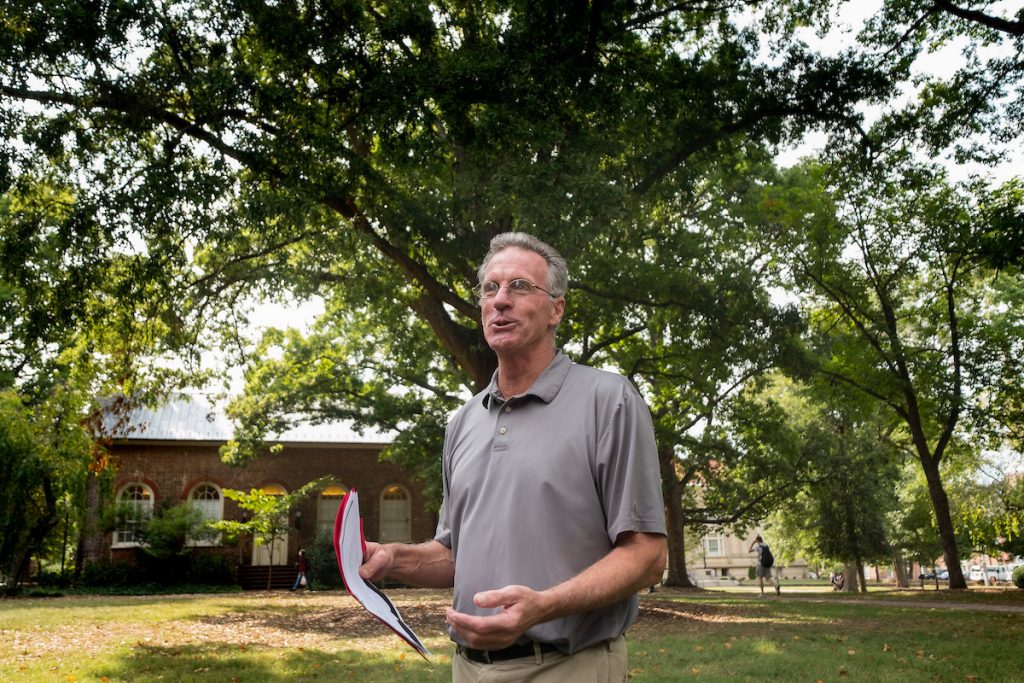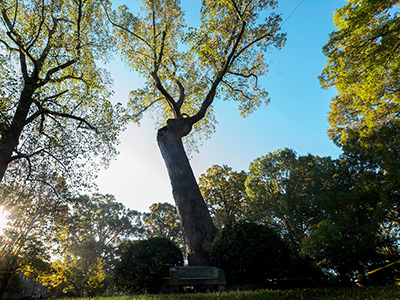University arborist Tom Bythell uses trees to connect future generations of students to history.

The way Tom Bythell sees it, the trees are as much a part of the cherished Carolina landscape as the brick walkways, the rock walls, the Old Well.
That’s because, from the very beginning, they have been a part of the Carolina story, starting with the Davie Poplar beside which, as legend has it, the University’s founders planted the seed for what would become the country’s first public university.
There is simply no better way to get to know Carolina than to get a tour of its trees, Bythell believes. Maybe that is why, when Margaret Spellings visited campus soon after she began her job as UNC System president, Bythell was the first person on campus to greet her.
Their first stop was the Davie Poplar.
Living history
When Bythell was hired as the University arborist in spring 1998, he estimated there were about 20 trees, like the Davie Poplar, that had been standing before the campus.

Each time one of them falls, he feels it.
And when the Davie Poplar came under attack two months ago, he raced to the scene to do what could be done to save it.
On the afternoon of Nov. 2, Bythell rushed to the Davie Poplar minutes after he heard the news that an explosive device had been set off next to its trunk. He was turned away from the yellow tape that marked the area as a crime scene.
When he returned the next morning, he was relieved to find the damage posed no threat to the tree. The explosion was intense, but the fire was put out before it could burn through the bark and reach the cambium—the life-giving membrane between the inner bark and outer rings, he said.
Finding the connection
For Bythell, the incident—and the national coverage it spawned—served to reinforce his long-held conviction that there is no place in the world like a college campus where people are as passionate about trees.
And the older the campus, the more passionate they are. Bythell would know. Before coming to work at Carolina, he served as head arborist for Princeton University, founded in 1746.
Bythell told the story of the phone call he got from a distraught alumnus about an old tree that his crew took down after it died.
“Why,” the man asked, “did you take my tree down?”
The man had met his future wife under that tree, he told him. He had proposed to her under that tree. Whenever he and his wife were in Chapel Hill, they had always made a trip to that tree in homage.
“I loved that,” Bythell said. And in a way, the tree really did belong to that couple because the trees belong to everybody, he said.
Because the tree had only recently been taken down when he received the call, Bythell was able to find and send sections of the trunk for the couple to treasure for the rest of their lives.
Then there was the student body president—the one who accompanied Spellings to the Davie Poplar in spring of 2015—who later contacted Bythell to ask if it would be possible to get Davie Poplar seeds.
He was getting married, he told Bythell, and wanted to give seeds from the Davie Poplar as wedding favors. He needed 200, and 200 was what he got, each one taped to a peat pot filled with soil.
The persimmon on Polk
Bythell and his crews in Facilities Services plant anywhere from 80 to 100 trees a year.
Some of those trees are planted simply to provide shade, others for their beauty.
Some replace ancient trees that have died, keeping their part of the Carolina story alive for future generations.
“This is a forever campus,” Bythell likes to tell people when explaining what he does. “I’m planting for our grandchildren.”
Next March, Bythell will mark 20 years on a job that continues to create opportunities for him to grow in unexpected ways.
“This job has never gotten old for me, and I don’t think it ever will because I always keep finding new things to do,” Bythell said.

In 2009, for instance, Bythell collaborated with Carolina landscape architect Jill Coleman and Michael Dirr, professor emeritus at the University of Georgia, to produce the book The University of North Carolina at Chapel Hill’s Noble Grove: A Walking Tour of Campus Trees.
The book inspired a 2010 exhibit at Wilson Library and spawned dozens of campus tours like the one Bythell led this fall with Edible Campus coordinator Laura Mindlin.
The purpose of this tour was to showcase the North Carolina Botanical Garden’s Edible Campus Initiative, a two-year-old project with a network of edible garden beds.
But Bythell was quick to point out that the idea of an edible campus was as old as the campus itself. Horse chestnut and persimmon trees once dominated the grounds in the 19th century because of the nuts or fruit they produced—and the fresh game they helped to attract.
The last of the old horse chestnuts died in the mid-1980s. After he arrived, Bythell planted a horse chestnut on McCorkle in homage to its past significance. Similarly, Bythell took the group to the persimmon tree he planted by Manning Hall to replace the persimmon tree that had once been there.
All the other trees in Polk stood sentry in neat rows over the quad, making the persimmon seem out of place.
But because of its link to the past, Bythell explained, it belonged.
Story by Gary Moss, University Gazette
Photos by Jon Gardiner, University Communications
